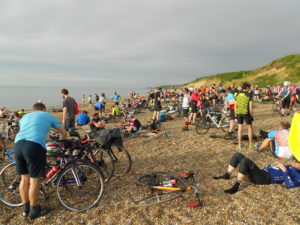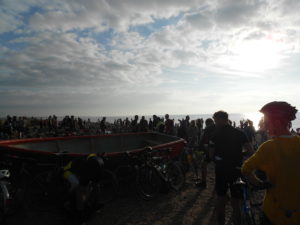21 July 2016
Pedalling to Atlantis
The Dunwich Dynamo
by J.R.Thomas
 Plato started it. Not pedalling; the legend of Atlantis. It was the fictional city-state which in its political theories dared attack Athens and, as punishment for its hubris, sank into the Atlantic. So compelling was this concept, of the arrogant city-state sinking below the ocean, that it has become the classic warning to the proud and over-powerful in many a moral tale.
Plato started it. Not pedalling; the legend of Atlantis. It was the fictional city-state which in its political theories dared attack Athens and, as punishment for its hubris, sank into the Atlantic. So compelling was this concept, of the arrogant city-state sinking below the ocean, that it has become the classic warning to the proud and over-powerful in many a moral tale.
But what most myth makers and story recyclers have missed is that Atlantis was not in the Atlantic at all, but by the North Sea, in Suffolk, on that shingly coast that stretches up from Ipswich to Great Yarmouth. Here, close to the River Blyth, was, by the 12th century, the city of Dunwich, former capital of the Kingdom of the East Angles, then a great early mediaeval centre and a major port for the European trade. It was said to be almost the same size as London when it was struck by a great storm in 1286, which changed the shape of the coastline and took a good part of the city with it. Then, and in further storms over the succeeding years, most of the proud city was reduced to a town, then a village, now finally, a sleepy hamlet.
It is difficult to imagine what was once there, that a city subsided into a gravelly grave; three priories, a majestic town hall, and at least nine churches, joining hundreds of more humble dwellings in swimming with the fishes. On a quiet night, the locals say, you can still hear the bells of those churches ringing, as a warning, or, perhaps, in celebration of the life aquatic.
But Dunwich sank not with the fishes, but before the fishes arrived. Great Yarmouth and Lowestoft were unregarded shoreside hamlets when Dunwich was the leading East Anglian sea port. Dunwich began its slow slide under the shingle a couple of hundred years before a strange migratory event, not yet explained, the arrival of massive shoals of herrings to take up permanent seasonal residence in the North Sea. That was the making of Yarmouth and Lowestoft, but too late for our North Sea Atlantis. It had gone, and nobody could be bothered to do much about it. Until now.
Because now a great new seasonal migration seems to be becoming a permanent feature of the Dunwich calendar, and perhaps Dunwich will yet see the great fortune that herring brought to its neighbours. The Dunwich Dynamo has arrived.
 Like the herrings, the new migration is seasonal and scientists have not yet really managed to explain why it began and why it continues. The herring movements are said to be affected by the moon, and one thing we do know about the Dynamo is that it is most certainly connected to the cycles of the moon – so closely that it occurs each year on whichever Saturday in July is closest to the full moon. On that night the curious should begin by stationing themselves not at Dunwich but in London Fields, east London, where the migration begins.
Like the herrings, the new migration is seasonal and scientists have not yet really managed to explain why it began and why it continues. The herring movements are said to be affected by the moon, and one thing we do know about the Dynamo is that it is most certainly connected to the cycles of the moon – so closely that it occurs each year on whichever Saturday in July is closest to the full moon. On that night the curious should begin by stationing themselves not at Dunwich but in London Fields, east London, where the migration begins.
What you find, in Richmond Road, E14, as dusk approaches and the Saturday evening traffic hums and beeps in the streets, are cyclists. Hundreds of them, each equipped with strong headlights and back lights, two water bottles strapped to every frame, little mysterious bundles tied under the slim saddles and bigger ones to the handlebars of an extraordinary range of bicycles. This is indeed the migration, bikes and riders, from London Fields to Dunwich beach. Where once the fabled city stood, in seven hours or more, shortly after dawn or, for exceptionally fit ones, slightly before, the cyclists will stand, sweaty, smelly, exhausted, triumphant, in an ever swelling crowd. Do they, in moments of silence, hear the church bells ringing under the cold waters? Certainly, some are prepared to strip off and plunge into the grey chill to listen for sounds, mostly shrieks about the cold, and to swim with the herring, except of course, the herring are long gone.
As the sun rises the scene becomes surreal, a beach full of bikes, with bikers in shorts and helmets, drinking beer from bottles and eating burgers. To the north the church tower at Southwold end-stops the stage, the nearby lighthouse flashes the beach and its strange contents, and to the south is a giant golf ball – a very foreboding golf ball, the reactor of the nuclear power station at Thorpness.
 The talk is of matters so technical it is difficult to understand, advanced things to do with gears, brakes, chains, tyres. But also of hospitality en-route, of the generosity of a fire brigade somewhere in Essex – or was it in Suffolk? – who made and sold a thousand burgers, including veggie and vegan, and gave the proceeds to charity; of householders who stood outside not to complain but to cheer; of the bewildered drunk staggering home down a country lane suddenly engulfed by thundering cyclists. There are multi-geared bikes, racing bikes with no gears or brakes, fold-up Brompton bikes, and some years (none visible this year) Boris bikes (£50 that will cost, and £300 if you don’t return it within 24 hours).
The talk is of matters so technical it is difficult to understand, advanced things to do with gears, brakes, chains, tyres. But also of hospitality en-route, of the generosity of a fire brigade somewhere in Essex – or was it in Suffolk? – who made and sold a thousand burgers, including veggie and vegan, and gave the proceeds to charity; of householders who stood outside not to complain but to cheer; of the bewildered drunk staggering home down a country lane suddenly engulfed by thundering cyclists. There are multi-geared bikes, racing bikes with no gears or brakes, fold-up Brompton bikes, and some years (none visible this year) Boris bikes (£50 that will cost, and £300 if you don’t return it within 24 hours).
Not all the Lycra clad horde chat or high-five. Many just fall asleep on the shingle, bikes propped behind them, socks gently steaming as the sun rises. The wise ones, who have done this before, bring inflatable mattresses. Nothing seems to wake them; though a bottle of beer in close proximity seems to work if necessary.
As the numbers have grown, so has the sophistication of the arrangements, though not too much. The organisers, who began as a group of London bike couriers who wanted a challenge, but are now part of a larger London cycle club, want it kept informal, free to enter, and with no winners. The only fee is a pound for the route map, though with getting on for 2,000 participants, it seems unlikely that you will get lost, even if the full moon is lurking behind July clouds.
One thing that is now organised is transport home – a fleet of buses and lorries to get bikes and riders back to central London. This is regarded as slightly wimpish behaviour by the old hands who have done the Dynamo many times before. Soon after dawn they can be seen cycling in relaxed style through the woods and heathlands to Lowestoft or Ipswich stations to catch the London train. They, in turn, are categorised wimps by those who reach the beach, wolf a burger, refill their water bottles – and set off to bike back to London. This year (the night of 16th July) provided yet a further alternative – the Dynamo coincided with Latitude, the up-market music festival, a sort of Glastonbury for those too posh to go to Glastonbury, ten miles or so up the road, so some bikers were off there for cool music and cold drinks.
200 kilometres, in case you were wondering, 120 miles if you wonder in an old fashioned way. 200 kilometres back, as well, for those so inclined. It is relatively flat, of course – though maybe don’t argue that one too hard with a red-faced biker newly arrived on Dunwich beach. He has in fact climbed (and descended) over 1,000 metres, and he has done that, through the night, on London potholed tarmac and on the country roads of Essex and Suffolk, dodging badgers, cats, other cyclists, discarded bottles of water, and wandering drunks.
To sit on that beach, thinking of what was once there, and pondering the distant brooding strange shapes of nuclear Thorpness, where a moment’s carelessness could once again fundamentally change the landscape, is a different way to start a summer Sunday indeed. But the philosophical cares of the world will soon be overcome by more immediate ones – such as a sore bottom, intense hunger, cramping legs, and an overwhelming urge to sleep. “Never again”, they vow – but they’ll all be back next year.
If you enjoyed this article please share it using the buttons above.
Please click here if you would like a weekly email on publication of the Shaw Sheet

